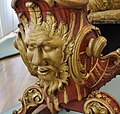Green man

As Green Man certain architectural decorative elements of sacred and profane buildings are medieval and early modern period referred to. Mostly a male head is depicted, whose hairs on the head and whiskers are in the shape of leaves that also grow out of the mouth. The illustrations often resemble those of the Wild Men . Lady Raglan coined the name in 1939 with her essay The "Green Man" in Church Architecture . At that time, the term sheet mask was already common in German-speaking countries .
Theories of origin

According to Nana Nauwald, the myth of the Green Man goes back to pre-Christian times; he survived in German, English and French Gothic and High Gothic cathedrals , in which the Green Man was depicted as a leafy face in hundreds of sculptures in corners, lintels and pedestals.
In the Rheinisches Landesmuseum in Bonn there is a Celtic stele with the so-called “ Pfalzfeld column ” , on which a head with mistletoe leaves is depicted. This depiction thus takes up two Celtic motifs: the head cult , which regarded the head as the bearer of all strength and also worshiped the life force of enemies in the severed heads, and on the other hand the mistletoe, which, according to Pliny the Elder, was given a gold by the Celtic druids Sickles were cut from oaks and other trees when the moon was in a particular position, in order to catch them in white cloths and with them to heal diseases and to strengthen and stimulate the general life forces. The mistletoe leaf is also assigned to the Celtic god Esus , to whom all forces of growth are subject. Both elements, the head and the medicinal plant, can be found in the motif of the Green Man.
In one case, the head of the Green Man bears the inscription “ Silvanus ”, which refers to the Roman god of the forest and thus refers to an interpretation as a personification of a natural society.
Representations
A figure appears on the right pillar of the portal of St Mary and St David's Church in Kilpeck . A woodcut is in the Church of the Holy Ghost at Crowcombe, Somerset . The green man of Sampford Courtenay in Devon is cut in St. Andrew church at the intersection of a cross on a wooden panel.
"Green Man" in the Rosslyn Chapel (16th century)
Misericordie in the Abbey of La Trinité (Vendôme) (16th century)
Sheet mask on the magnificent sleigh of Duke Carl Eugen von Württemberg (1728–1793)
Final "stone" in the ceiling of Bolton Abbey
See also
literature
- William Anderson: The Green Man, An Earth-Connected Archetype. ISBN 3-530-01490-7 .
- Tom Cheetham: Green Man, Earth Angel: The Prophetic Tradition and the Battle for the Soul of the World. SUNY Press, 2004, ISBN 0-7914-6270-6 .
- Fran Doel, Geoff Doel: The Green Man in Britain. Tempus Publishing Ltd, 2001, ISBN 0-7524-1916-1 .
- Clive Hicks: The Green Man: A Field Guide. Compass Books, 2000, ISBN 0-9517038-2-X .
- Mercia MacDermott: Explore Green Men.Explore Books, Heart of Albion Press, 2003, ISBN 1-872883-66-4 .
- Gary R. Varner: The Mythic Forest, the Green Man and the Spirit of Nature. Algora Publishing, 2006, ISBN 0-87586-434-1 .
Web links
- The Green Man: Variations on a Theme
- The Green Man of Cercles Julianna Lees on Green Man sculptures in Romanesque Churches in France
- Sampford Courtenay, Devon Picture
Individual evidence
- ^ Julia Somerset (née Hamilton), Lady Raglan (1901-1971): The "Green Man" in Church Architecture . In: Folklore . 50, No. 90990, March 1939, pp. 45-57. JSTOR 1257090 . ; The Hon. Julia Hamilton on thepeerage.com , accessed August 19, 2015.
- ↑ Nana Nauwald: Bear strength and jaguar medicine. AT-Verlag, Aarau (Switzerland) 2002. pp. 74-75.







